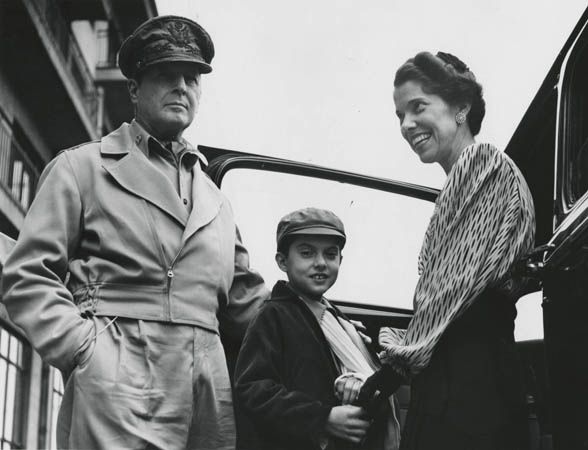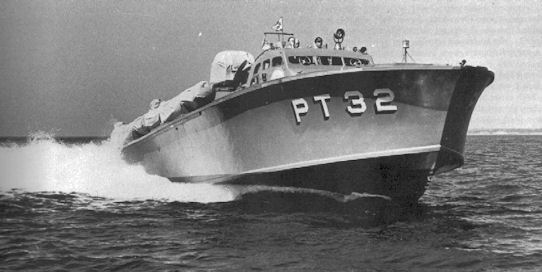General Douglas MacArthur and his family were stationed on the island of Corregidor during the Pacific Campaign of World War II, where he supervised more than 90,000 American and Filipino soldiers engaged in combat with the Japanese army. As Japanese forces seized control of nearby strongholds, U.S. President Franklin Roosevelt started to worry that Corregidor would follow suit and that MacArthur, a respected commander, would be taken prisoner or killed. The President asked General MacArthur to depart the island, but when he was given the go-ahead, he resisted. MacArthur promised before he departed, "I Shall Return."
MacArthur desired to continue serving the troops.
Despite the risks to his wife Jean and son Arthur, General Douglas MacArthur was adamant about leading his forces. The first time Roosevelt told MacArthur to abandon the island, the general replied that he intended to meet the same end as the soldiers. A few days later, MacArthur received similar advice to depart from the U.S. Army Chief of Staff George C. Marshall. MacArthur declined once more. Forcing MacArthur to depart required a clear order from the US president.
During MacArthur's Escape, Treacherous
On a PT boat, MacArthur, his family, and a number of other senior military figures left Corregidor. To get to the Philippines, which were more than 550 miles distant, they had to cross dangerous waters while avoiding the Japanese army, sea mines, and bad weather. Even though the 35-hour trip was complete, it wasn't yet. After that, MacArthur flew a B-17 to the northern Australian coast before taking a different aircraft, a train, and a final plane to Melbourne.

The commander hoped to locate allied forces in Australia.
There were about 90,000 American and Filipino soldiers on Corregidor and the adjacent Bataan Peninsula when General MacArthur departed. He understood that they could not successfully repel the Japanese for very long without assistance and provisions. MacArthur hoped that Australian-based Allied forces would be able to assist him in getting the troops out. He was disappointed to learn that there were significantly fewer Allied forces in Australia than he had anticipated.
Release of a Media Statement by MacArthur
In order to rejoin his soldiers, carry on the battle, and guide as many of his men as he could to safety, General MacArthur was adamant about it. He gave the media a speech in Melbourne. He gave his troops and the people of the Philippines a promise in it that he would return. Over the following two years, he stated "I shall return" multiple times. In fact, it was a recurring subject in the majority of his speeches in public.
Australia Defense was MacArthur's New Command.
MacArthur was given the responsibility of leading the Allied forces in the Southwestern Pacific to defend Australia after being forced to abandon Corregidor. Hearing that the Japanese had seized Bataan made him melancholy. The number of American and Filipino troops taken prisoner exceeded 70,000. About 7,000 of them died during the death march that was imposed upon them. Another 15,000 Allied soldiers were taken prisoner when Corregidor was given over to the Japanese a few months later.

There were no plans made for their release.
The Joint Chiefs of Staff of the United States were not planning a campaign to free the captured American soldiers; instead, they were concentrating on other objectives. After winning the Battle of Midway, Admiral Nimitz intended to continue on to Japan. Yet MacArthur had a strategy. With his meager troops, he had triumphed in a number of smaller battles, including one in New Guinea. He was getting ready to attack the Philippines, but he required more assistance. Nimitz had to move his troops away from Japan and toward the Philippines.
MacArthur receives backing for his strategy
The Joint Chiefs of Staff agreed to back General MacArthur's plan to invade the Philippines after some persuasion. He made preparations to land in the Philippines and free the nation and his troops from the Japanese forces, with the addition of Nimitz's forces. On October 20, 1944, two and a half years after MacArthur was compelled to flee the nation, the invasion started.
"I've Returned"
It was only fitting that MacArthur made a radio broadcast just hours after setting foot back in the Philippines in which he announced, "People of the Philippines, I have returned!" since "I Shall Return" had been his catchphrase for the previous two years. The Allied forces labored to drive the Japanese out for the ensuing ten months. Only a third of MacArthur's original soldiers were still alive when the conflict was over. I'm a little late, but we've finally arrived, he said, adding that.



















